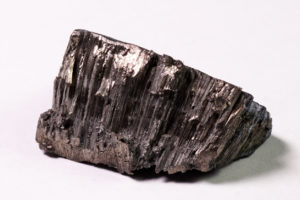That is why a new paper seeking to link infusions containing the gadolinium that enhances MRI scans to side effects such as nephrogenic systemic fibrosis, which affects organs like the skin, needs to be read with caution. Gadolinium is used in contrast agents because it aligns well with a magnetic field, which means better images during MRIs, even including blood vessels. Due to known toxicity at high levels, it is bound to "chelating" molecules which are then excreted.

Gadolinium. Credit: LYagovy/iStock
Seems simple enough, except nothing is simple in 2023. Where once the dose determined the poison, it has become common this century to instead try and link even the presence of any pathogen to actual pathology. If you use an electron microscope to detect gadolinium in the kidneys of people who had contrast agents before their MRIs you can suggest harm. If you believe any dose is a poison, even a few atoms, you can suggest gadolinium atoms somehow leach out of the contrast agents and put people at risk.
Yet scientifically that is not true.
Caution is warranted because it was a pilot finding from five patients. If the results are found beyond such pilot study epidemiology, there may be reason for concern, since contrast agents with gadolinium are used in a third to a half of MRI scans, but it has to be more than a few people to suggest a real correlation. When you take people who have gotten nephrogenic systemic fibrosis and note some only had a single exposure, you can scare people, but it doesn't hold up. Some who had a lot of MRIs got a rare disease - impossible to link because it is so rare and thus has no large studies - and some who had only a little got it.
That kind of u-shaped curve is more like homeopathy than science.
Detection of a few atoms is not making any difference but the authors still suggest that even though they don't have any idea how trace atoms of gadolinium may detach from the chelating molecules, it is still a problem, but chemists, biologists, and toxicologists disagree. If people with chronic kidney disease get nephrogenic systemic fibrosis, a lot of more obvious things may be involved but they also double-down on scariness and note that because gadolinium is expelled through urine, and sewage treatment plants don't remove it, it could make its way into drinking water. Then, hoping journalists don't understand absolute and relative risk (they usually don't), the authors say that San Francisco gadolinium levels have grown 2000%. Anyone dumb enough to buy 20 lottery tickets knows that it didn't help and 20 atoms of a toxic metal versus one may get attention from the siloed conspiracy theorists in the NYU Journalism department but it is meaningless in the real world.
We can measure the effect of a fly's wings on the moon but if you recognize that's cool yet meaningless in the physics of your day-to-day life you also should not worry that detecting a rare earth metal's atoms means you are risking your health.
Gadolinium has been detected in soft drinks in Germany, they write. Okay, so what? We can detect parts per quadrillion now, which means you can quite literally detect anything in water, and therefore water-based drinks.
The problem is the same that shaky epidemiology always faces: There are 30,000,000 MRIs per year just in the US, so where are the dead bodies? We're at 30 years of MRIs being common and saving lives, which means 30 years of people peeing this toxic rare earth metal into treatment plants and often back to water, and yet instances of the disease they link to it have not gone up.
This is not the first time concern about gadolinium has been raised. The plural of anecdote is not data but if enough people say they felt bad a day after an MRI the science community will take a look. It is just that there are so many variables and no evidence of a link to a disease, which is why outside a few isolated academic labs no one has spent money on efforts to prevent any deposits that happen.
NOTE:
(1) Because health care is now controlled by the government, but trial lawyers run it, you are told to drink a lot not because they are worried but rather that health care culture is now 'teach to the protocol' and 'defensive medicine', meaning don't be creative (sorry, "House, MD", you have been forced into retirement) on one side and on the other they are going to list every caution no matter how lottery-winning risk it is, and run every test, etc. to prevent malpractice lawsuits.




Comments